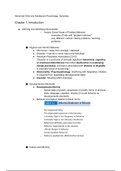Abnormal Child and Adolescent Psychology; Summary
Chapter 1: Introduction
■ Defining and Identifying Abnormality
○ Accent: Some Faces of Problem Behavior
⠂ examples of kids with “problem behavior”
⠂ very different; cultural / family problems / learning
problems
☗ Atypical and Harmful Behavior
● Ab-normal = away from average / standard
● Disorder = harmful in some way to the individual
● American Psychiatric Association (2013)
“Disorder is a syndrome of clinically significant behavioral, cognitive,
or emotional disturbances that reflect dysfunction in underlying
mental processes, and that is associated with distress or disability
in important areas of functioning.”
● Abnormality / Psychopathology: Interfering with Adaptation; Hinders
or prevents from negotiating developmental tasks
● Disorder: Residing within individual
☗ Developmental Standards
● Developmental Norms
○ typical rates of growth, sequences of growth, forms of physical
skills, language, cognition, emotion & social behavior as
developmental standards
● Behavior anomalous relative to these norms
○
☗ Culture and Ethnicity
, ● Culture; groups of people organized in specific ways, live in specific
environmental niches, share specific attitudes, values, beliefs,
practices, behavioral standards
● way of living ; transmitted from generation to generation
● cross-cultural differences in rates of disorders
○ e.g. anxiety disorder
⠂ Asian/Latino: bodily symptoms
● cultural norms …
○ shape normal & abnormal behavior
○ conceptualize, explain and treat psychopathology differently
○ influence expectation, judgement, beliefs about behavior
● Examples
○ Thai teachers report more problems; higher demands
○ Different explanations for behavior; Demons, etc.
● Ethnicity: common customs, values, language, traits; associated with
national or geographic origin
● Race: distinction based on physical characteristics, associated with
shared customs, values
→ Show different rates/ expression/ beliefs about it
● example of ethnic difference in the US
○ Asian American vs. European American parents
⠂ AA: M greater importance of child's effort than to ability
→ disabled kids; lower expectations, etc: different
emotional reaction
☗ Other Standards: Gender and Situations
● gender norms
○ affect emotions, behaviors, opportunities, choices
○ for males: aggressive, dominant, active, adventurous
for females: passive, dependent, quiet, sensitive, emotional
○ play role in judgement of normality
● situational norms
○ what’s expected in specific settings/ social situations
●
☗ The Role of Others
● referral of youth to mental health professional relays on other
○ characteristics of parents, teachers. etc.
, ☗ Changing Views of Abnormality
● due to advancements in knowledge etc.
→ Psychopathology
NOT simply entity carried within a person
BUT judgment that a person’s behavior, emotion or thinking is atypical,
dysfunctional, harmful INVOLVING knowledge about development, cultural and
ethnic influences, social norms & people making the judgment
■ How Common are Psychological Problems?
● frequency depends on several factors
○ e.g. definition of disorder/ criteria set / source of information /
population characteristics
○ several countries; Disorders in Youth range 5.4-35.5%
○ U.S. survey: 13-22%
○ APA (2007): 1o serious, 10 mild to moderate
● secular trends
○ study; data in 1987, 1999, 2006, self-reports psychological
stress
○ key changes; economic, family, e ducation, values, lifestyle
⠂ also more maternal problems
○ increases stress girls to 1999, both to 2016
○ increases in emotional problems for 2006, more reported from
girls
○ worry, irritability, fatigue, sleep problems, panic, feeling worn
out
○ BUT findings are mixed, some also show decreases
● ⅔ to ¾ of needy youth do not receive proper treatment
● early problems -> accumulation later (often first symptoms at age 14)
➢ Accent: Infant Mental Health
○ Birth to 5 years
○ Important Aspects
⠂ Caregiving context is important
⠂ criteria that is reliable, valid & sensitive to
developmental changes
⠂ primary health care practitioners must have enough
knowledge
⠂ early prevention is especially effective
○
, ■ How are Developmental Level and Disorder Related?
● chronological age is correlated with developmental level; increased
likelihood of some disorder
● can give useful information
○ early onset: genetic and/or prenatal etiology
○ late onset: influence of additional developmental changes
○ judging severity of disorder regarding stage at specific age
○ more sensitive to symptoms knowing usual onset; better
treatment
☗ How are Gender and Disorder Related?
● males are more frequently affected
● some are related to age; male vulnerable to neurodevelopmental
disorders occurring early, females to emotional problems later
● Methodological Issues must be considered
☗ Methodological Issues, True Differences
● gender-specific prevalence can be affected by referral bias or gender
more willing to report
● criteria based on symptoms seen in boys; symptoms may be different
in girls
● Differences due to:
○ differential biological vulnerabilities and strengths
⠂ sex chromosomes, sex hormones, brain structure &
function
⠂ different biological maturity






